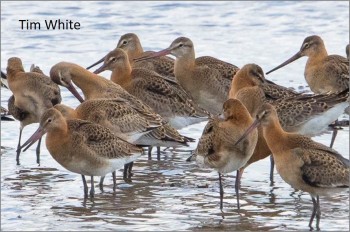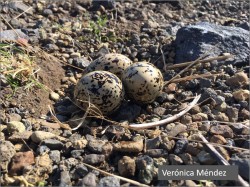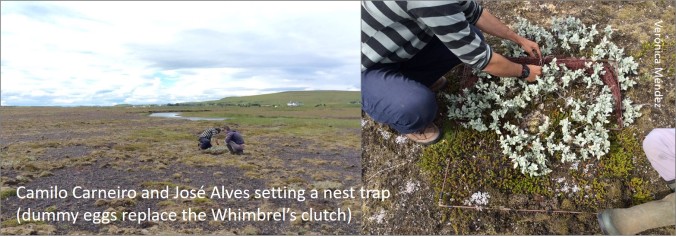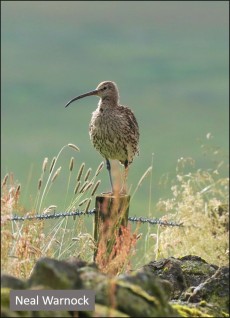 In a changing world, with more chaotic weather patterns and rapidly altering habitats, migratory birds are faced with opportunities and challenges. Long-term monitoring of colour-ringed Black-tailed Godwits, during a period of range expansion and phenological change, has revealed that individuals behave consistently over time but that the behaviour of new generations is moulded by the conditions they encounter.
In a changing world, with more chaotic weather patterns and rapidly altering habitats, migratory birds are faced with opportunities and challenges. Long-term monitoring of colour-ringed Black-tailed Godwits, during a period of range expansion and phenological change, has revealed that individuals behave consistently over time but that the behaviour of new generations is moulded by the conditions they encounter.
A changing world
When trying to explain observed changes in the distributions and annual cycles of migratory birds, there are many things to consider:
-

Colour-rings enable life-time tracking. This bird, caught on its nest, had been ringed as a chick.
Are individual birds able to take advantage of new breeding and non-breeding sites, as they become available, particularly if other areas become less suitable?
- Are individuals able to change the timings and patterns of migration?
- Do individuals adjust their migration routes as a consequence of changes in stop-over or wintering areas?
- If individuals do not change what they do, how do we explain range expansions and changes in timing of migration?
Put simply, how does climate change lead to changes in distribution of migratory birds? Answering this question is key to being able to predict the rate and direction of future changes, and to assess whether our existing networks of protected sites will continue to support populations in the way that was intended. This issue was tackled by Jennifer Gill, José Alves and Tómas Gunnarsson in their paper “Mechanisms driving phenological and range change in migratory species”, published in Linking behaviour to dynamics of population and communities: applications of novel approaches in behavioural ecology and conservation, a special issue of Philosophical Transactions B (Royal Society).
Potential models
Change could happen in two main ways:
- Individuals could relocate – having knowledge of a range of available conditions, they can choose to move elsewhere.
- New generations could settle in new areas (in the breeding season, the non-breeding season or both) and/or adopt new migratory strategies.

Map that illustrates range expansion
Working out whether change happens through individual movement or generational shifts can only be done by life-long tracking of individuals, in populations in which range change is happening. The Icelandic population of Black-tailed Godwit is ideal for such an investigation. Black-tailed Godwits have been expanding into new breeding areas of Iceland for over 100 years, as discussed in this WaderTales blog. Population growth has been facilitated through warming spring conditions, as discussed in From local warming to range expansion.

Naive youngsters, gathering together before migration
Icelandic Black-tailed Godwits fly south in the autumn, to spend the winter in the British Isles, The Netherlands, Belgium, France, Spain and Portugal. As numbers have grown, winter counts have increased in many areas, with new flocks appearing and expanding on estuaries and areas of wet grassland where the species was previously absent or scarce.
Winter distribution
The Wetland Bird Survey shows that there are three times as many Black-tailed Godwits wintering in Great Britain as there were 25 years ago. The biggest changes in numbers have occurred on estuaries in the northwest of England, with the Morecambe Bay winter maximum rising from about 180 to 3200, for instance. Where have these extra birds come from?

These young birds happen to have ended up on the Axe Estuary in Somerset
Black-tailed Godwits have been ringed in Iceland for nearly twenty years, providing a pool of known-age adults for which natal sites are known. Winter observations of colour-ringed individuals have shown an interesting pattern; birds breeding in newly-colonised areas, particularly in north and east Iceland, are the ones that are more likely to be found in newer winter sites.
In their paper, the authors suggest that birds nesting in these colder areas, where spring comes later, will be fledging quite late and leaving Iceland after adults have departed. With no experienced birds to follow, these young birds may well stop off at the first suitable site, many of which are in the north of the wintering range, and then they return to breed in their natal sites. Birds in Morecambe Bay don’t know that days are longer and the weather is kinder for other birds that travel further south to wintering areas such as Portugal.

Wintering birds in Northwest England
Observations from birdwatchers show that the same colour-ringed individuals are nearly always found at the same wintering sites each year. Whatever mechanism is producing this new-breeding-site to new-wintering-site link, it is becoming clear that older birds continue to do what they have always done, with changes in distribution happening as a result of a generational shift.
The annual cycle
Colour-ringed Black-tailed Godwits have been tracked for over 25 years, with a small number of individuals contributing data for the whole of this period. This tracking information can be used to ask how much individuals move around and experience different sites and to assess whether individuals from different generations are using different parts of the range.
Using colour-rings, the Black-tailed Godwit team has discovered that, although individuals can live for over 20 years, in that time they generally use a total of only about four sites between leaving Iceland in late summer and returning in the spring. Basically, individual birds have very limited experience of sites and there is no evidence that they have moved to occupy different sites as, for instance, winter conditions have changed.

Spring arrivals in Iceland
Colour-ring observations have shown that individual birds do not change their breeding or wintering locations and that migrating individuals often appear in the same stop-over sites year after year. The timing of movements is also pretty consistent, especially in the spring. A previous WaderTales blog called Why is spring migration getting earlier? demonstrated that the timing of migration of individual Black-tailed Godwits varies very little, with observed shifts in the period of migration being driven by young birds returning to Iceland for the first time on average doing so somewhat earlier than previous generations. Once individual birds settle into a timing pattern, they stick to it.

Black-tailed Godwits, newly arrived in Iceland after crossing the Atlantic
Migration patterns
As discussed above, individual Icelandic Black-tailed Godwits have experience of only a small number of sites, which they use on an annual cycle. When migrating, a bird will generally use the same stop-over site when breaking its journey south, to undertake autumn moult, or on their way north, to take on fat for the trans-Atlantic journey. There is a range of spring migratory strategies in islandica Black-tailed Godwits, as discussed in Overtaking on migration.
 Once established, the annual migratory programmes of individuals rarely change, as illustrated by the map to the right. Colour-ringed Black-tailed Godwit W-WR/W regularly moulted on the Wash, in eastern England, before spending the late winter and spring in northwest England. In the late summer of 2002 he was reported at Slimbridge on 18th and 20th July but back on the Wash on the 25th. Having made the Atlantic crossing and ended up in southwest England, he was able to correct what he may have perceived to be his mistake, returning to the moulting area that he had been using since at least 1996.
Once established, the annual migratory programmes of individuals rarely change, as illustrated by the map to the right. Colour-ringed Black-tailed Godwit W-WR/W regularly moulted on the Wash, in eastern England, before spending the late winter and spring in northwest England. In the late summer of 2002 he was reported at Slimbridge on 18th and 20th July but back on the Wash on the 25th. Having made the Atlantic crossing and ended up in southwest England, he was able to correct what he may have perceived to be his mistake, returning to the moulting area that he had been using since at least 1996.
Individuals might not change their annual migration routes but we do see changes in numbers on different sites that are used during migratory stop-overs. In a paper published in 2018, Mo Verhoeven and colleagues investigated whether observed changes in migratory patterns of a population of the limosa subspecies of Black-tailed Godwit were caused by individuals altering their strategies or by generational change.
Limosa Black-tailed Godwits leave breeding areas in countries such as The Netherlands in late summer, heading south to either West Africa or Iberia, where they spend the winter. In spring they all gather in staging sites in Portugal and Spain, typically on rice fields. Over the course of less than ten years, the average peak number in Extremadura (Spain) has dropped from about 24,000 to 10,000, while the numbers on the Tagus and Sado estuaries rose from 44,000 to 51,000. These changes took place during a period of rapid population decline, as described in this blog focusing on a paper by Rosemarie Kentie and colleagues.

Limosa Black-tailed Godwits feeding in a rice field in the Tagus estuary
Mo Verhoeven et al have shown that this rapid population-level shift in spring stop-over sites from Spain to Portugal, 300 km further west, was driven by young godwits increasingly using Portugal in the period January to March, instead of Spain. Nearly all of the older birds stuck with the routes they knew. The paper is Generational shift in spring staging site use by a long-distance migratory bird.
Change happens to birds
One thing that is becoming clear in Black-tailed Godwits is that birds are being affected by change – individuals do not have the knowledge or flexibility to effect change. Even in long-lived birds, like Black-tailed Godwits, we see no evidence of individuals altering what they do over what is now two decades, despite the fact that the species’ migration dates, wintering areas and migration routes have all perceptibly changed over the same time period. It’s all about generational change. The behaviour patterns of young birds arise from the conditions they encounter in the first year of life, after which they are repeated.
Details of the Generational Change paper by Gill et al
 The paper at the heart of this blog is: Mechanisms driving phenological and range change in migratory species by Jennifer Gill, José Alves and Tómas Gunnarsson, from the Universities of East Anglia (UK), Aveiro (Portugal) and Iceland. It is published in Linking behaviour to dynamics of population and communities: applications of novel approaches in behavioural ecology and conservation, a special issue of Philosophical Transactions B (Royal Society).
The paper at the heart of this blog is: Mechanisms driving phenological and range change in migratory species by Jennifer Gill, José Alves and Tómas Gunnarsson, from the Universities of East Anglia (UK), Aveiro (Portugal) and Iceland. It is published in Linking behaviour to dynamics of population and communities: applications of novel approaches in behavioural ecology and conservation, a special issue of Philosophical Transactions B (Royal Society).
The paper could not have been produced without the help of “thousands of observers of colour-ringed godwits who have made these analyses possible”. This WaderTales blog is a celebration of the work they do: Godwits and Godwiteers.
WaderTales blogs are written by Graham Appleton, to celebrate waders and wader research. Many of the articles are based on previously published papers, with the aim of making wader science available to a broader audience.

 Early return to breeding areas is widely acknowledged to be ‘a good thing’ but why? Some people suggest that early migrants can choose the best territories, others argue that early chicks have a disproportionately high chance of fledging but there are other explanations too. In their paper in Ecology & Evolution, Catriona Morrison and her colleagues ask how much of the advantage of being an early migrant could be associated with having an option to nest again, if the first attempt fails.
Early return to breeding areas is widely acknowledged to be ‘a good thing’ but why? Some people suggest that early migrants can choose the best territories, others argue that early chicks have a disproportionately high chance of fledging but there are other explanations too. In their paper in Ecology & Evolution, Catriona Morrison and her colleagues ask how much of the advantage of being an early migrant could be associated with having an option to nest again, if the first attempt fails.










 Geolocators* have provided fantastic information about the movements of migratory birds – making links between countries, revealing previously unknown stop-over sites and indicating just how quickly birds traverse our planet. A small number of Icelandic Whimbrel have carried geolocators for up to six annual cycles, providing Camilo Carneiro with an opportunity to investigate the annual consistency of egg-laying, autumn departure, arrival in West Africa, departure in the spring, stopover in Western Europe and arrival back in Iceland.
Geolocators* have provided fantastic information about the movements of migratory birds – making links between countries, revealing previously unknown stop-over sites and indicating just how quickly birds traverse our planet. A small number of Icelandic Whimbrel have carried geolocators for up to six annual cycles, providing Camilo Carneiro with an opportunity to investigate the annual consistency of egg-laying, autumn departure, arrival in West Africa, departure in the spring, stopover in Western Europe and arrival back in Iceland.



 Individual timings of autumn departure from Iceland varied between years. The repeatability index is 0.28, with a suggestion of a gender difference (females 0.40, males 0.02). Males tend to look after chicks for a longer period than females so their departure dates may be more strongly influenced by the success of each year’s breeding attempt.
Individual timings of autumn departure from Iceland varied between years. The repeatability index is 0.28, with a suggestion of a gender difference (females 0.40, males 0.02). Males tend to look after chicks for a longer period than females so their departure dates may be more strongly influenced by the success of each year’s breeding attempt. Spring arrivals in Iceland. Some Whimbrel that managed to complete spring migration in a single flight in some years stopped off in other years. These breaks, perhaps to wait for more helpful wind conditions and/or to refuel, resulted in variability in annual arrival dates for individuals. The repeatability for the two sexes combined was 0.23.
Spring arrivals in Iceland. Some Whimbrel that managed to complete spring migration in a single flight in some years stopped off in other years. These breaks, perhaps to wait for more helpful wind conditions and/or to refuel, resulted in variability in annual arrival dates for individuals. The repeatability for the two sexes combined was 0.23. The study of wader migration has advanced hugely.
The study of wader migration has advanced hugely.
 One or two WaderTales blogs are published each month. The series is UK-based with a global reach. Suggestions of newly-published research on waders that might be of interest to birdwatchers who appreciate waders/shorebirds are welcomed. I am particularly keen to give feedback to colour-ring readers; they provide a huge amount of information that lies at the heart of these stories.
One or two WaderTales blogs are published each month. The series is UK-based with a global reach. Suggestions of newly-published research on waders that might be of interest to birdwatchers who appreciate waders/shorebirds are welcomed. I am particularly keen to give feedback to colour-ring readers; they provide a huge amount of information that lies at the heart of these stories.